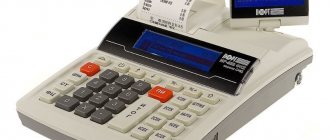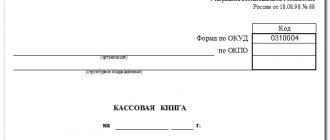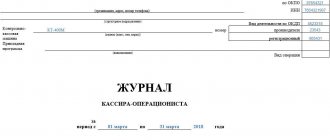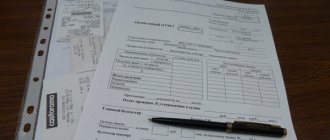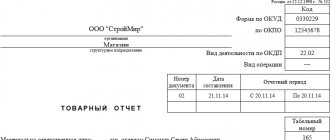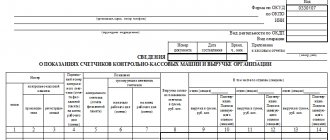Why is the KM-6 form needed?
Certificate form KM-6 is the main reporting document of the cashier. It indicates the revenue received and is handed over to the manager along with the revenue. If the proceeds are given to collectors, then a corresponding note is required in the certificate-report.
In the work of inspection bodies, such certificates play a very important role. It is on their basis that a conclusion is made about the completeness of revenue reflection. In addition, information from the KM-6 certificate is used to fill out a summary report. This report includes data on the status of cash register meters and the income of the enterprise.
Results
The result of the cashier’s work on a cash register equipped with EKLZ for a shift (cash revenue) is documented using the unified form KM-6. This report indicates the data of the cash register totaling counters and the amount of revenue received. The report serves as the basis for registering the receipt of cash proceeds to the taxpayer's operating cash desk. With the introduction of online cash registers, the need for such a report disappeared.
Sources
- https://assistentus.ru/forma/km-6-spravka-kassira-operacionista/
- https://nalog.wiki/spravka-otchet-kassira-operacionista/
- https://nalog-nalog.ru/buhgalterskij_uchet/dokumenty_buhgalterskogo_ucheta/unificirovannaya_forma_km6_blank_i_obrazec/
- https://praktibuh.ru/buhuchet/denezhnye-sredstva/nalichnye/dok/spravka-otchet-kassira-operatsionista-km-6.html
- https://nalog-spravka.ru/spravka-otchyot-kassira-operacionista-km-6.html
- https://blanki.biz/kkt/km-6/
- https://blanki.biz/kkt/km-4/
- https://assistentus.ru/forma/km-4-zhurnal-kassira-operacionista/
- https://nalog-nalog.ru/buhgalterskij_uchet/dokumenty_buhgalterskogo_ucheta/unificirovannaya_forma_km4_blank_i_obrazec/
Features of the help report
The cashier-operator's certificate-report has several characteristic features:
- the KM-6 form, approved by the State Statistics Committee of the Russian Federation in 1998, is unified;
- errors when filling out, as well as deviations from the generally accepted format, may result in a fine during the work of inspection bodies;
- KM-6 must be filled out daily (or at the end of each shift), and simultaneous filling out of certificates for 2 or more days/shifts is not allowed;
- The document must be submitted simultaneously with the proceeds - either to the chief cashier of the company or to the bank;
- The certificate must be kept for exactly 5 years, after which it loses its value.
Important! Column 4 is filled in only when using outdated cash register equipment. If modern devices have been installed in the organization over the past 12 years, then this section should be left blank.
Is it possible not to make
From July 1, 2021, online cash registers were introduced. Operational report KM-6 is not prepared for online cash registers. All necessary information is generated in the online cash register, in accordance with information on revenue per shift (Letter of the Ministry of Finance No. 03-01-15/37692).
IMPORTANT!
The organization independently decides whether to compile KM-6 or not. There is no legal requirement to fill out this report. In 2021, all information for the operating day is transferred to the tax office and printed for internal reporting from the online cash register.
General filling rules
In order to avoid mistakes when entering information into the KM-6 form, you must follow the general rules:
The first line of the report should contain the name, address (legal or actual - it doesn’t matter, the main thing is that it is the same in all reports) and telephone number of the enterprise. If there is a separate division, then its name must also be indicated.
If the KM-6 form is filled out by an individual entrepreneur, then he must indicate all the necessary information in the same order. This is a common mistake - many individual entrepreneurs believe that they can deviate from the unified form, because they work for themselves. The document must indicate the name, registration number and number of the CCP manufacturer. You must indicate the exact date of completion and certificate number. Revenue must be reported in numerical form and in words. The signature of the author of the certificate report is a required element.
Important! If the proceeds are not handed over to the company’s chief cashier, but to the bank, then this must be noted in the report.
No cash transactions
If no cash transactions were carried out during the working day (shift), then a certificate-report of the cashier-operator is not drawn up.
What is the penalty for not having a cashier-operator’s journal?
Keeping a journal is a legal requirement, so inspectors during on-site tax audits must look at its presence and content. Failure to register a journal may result in a fine (although this penalty is not specified in the law).
It should be noted that conflicts often occurred between business representatives and tax authorities on this issue, leading to court. And, as practice has shown, the administrative penalty for the fact that the enterprise did not keep a log of the cashier-operator was removed from him in most cases.
Is it possible not to fill out the KM-6 form?
This question is ambiguous. On the one hand, no one is fined for the absence of a certificate-report. Many enterprises simply do not require it, and individual entrepreneurs most often do without it. But if the check reveals the absence of such certificates, then this will be considered an “aggravating circumstance.” The manager will have problems, and naturally he will blame the cashier-operator who did not fill out the KM-6 form.
Sample certificate. Filling example
To learn more about the KM-6 form, download a free sample. It is in *.doc format and contains the correct form of help without factual errors or inaccuracies. This sample can be used not only to study the features of the certificate report, but also for the specific work of a cashier.
The cashier-operator's certificate-report is divided into 3 parts - line, tabular and final. For convenience, we will divide it into 3 parts and an example of filling it out so that the reader can quickly find exactly what interests him.
So, an example of entering information into the line part of KM-6:
- In the “Organization” field enter the name of the enterprise, its address, and contact telephone number.
- The identification number of the enterprise where the cashier works is entered in the TIN field.
- The “Structural division” field does not need to be touched if this division does not exist in the company.
- In the “Cash register equipment” field, information about cash register models is entered.
- In the “Number” field – the number of the cash register. This information, as well as the information for point 3, can be obtained from the senior cashier or read in the cash register documentation.
- The “Application program” field remains empty if such a program is not used.
- In the “Cashier” field, enter the cashier’s last name and initials. If a certificate is created for 2 or more sectors that have several cashiers, then the field remains empty.
- The number of the current Z-report is entered in the “Change” field. This is not shown in the sample, but it typically starts with the letter "Z". For example, "Z 0040".
Important! Next comes an intermediate field in which you need to enter the serial number of the reference report, the date of preparation, the start time of work on the report and the end time of work. These data cannot be ignored.
The tabular part of the certificate must be filled out as follows:
- Column 4 should also be left blank if modern cash register technology is used (since 2004).
- In column 5 enter the amount at the beginning of the day or shift. This amount can be found in the cashier-operator’s journal, in column 9. It was left there by the cashier who worked the previous shift. This amount is also in the morning X-report, in the GROSS TOTAL line.
- In column 6 enter the amount from the GROSS TOTAL line of the Z-report.
- In column 7 - the amount from the “Shift Total” line of the Z-report. If returns occurred during the day/shift, then you need to enter the shift total minus the returns.
- Column 8 should be left blank if there were no returns. If they were, then you need to enter the amount from the “Returns” line of the Z-report.
- In column 9, the cashier enters his last name.
- The cashier signs in column 10.
The sums of columns 7 and 8 are entered in the “Total” field.
Important! Empty columns can be crossed out. Cashiers often cross them out so that the inspection authorities know for sure that the document is completed completely and the cashier has not forgotten anything.
The final part of the certificate is completed as follows:
- The line “Total...” requires you to enter the proceeds in words.
- The line “Accepted...” should be left blank. It is necessary when a receipt order is issued for a report. In practice this rarely happens.
- The line “Delivered to the bank” contains information about the bank only if the report is handed over to the collector. If the proceeds and certificate are given to the chief cashier, then this line should be left blank.
- There is also no particular point in filling out the “Receipt No.” line, because it refers to the “Accepted...” line.
Next, you need to leave signatures and transcripts of the signatures of the operator, senior cashier and head of the enterprise.
Important points
If the cash register operator's journal is lost, a specialist from the cash register technical service center is called, he takes down a fiscal report (or a report from the EKLZ unit, if the company has a modern cash register with the letter “K”) from the cash register for the entire period from which the journal was lost.
But it would be better to check the dates with the tax inspector; the procedure for restoring the cashier-operator’s journal is not recorded anywhere, each department may present its own requirements.
Then a free form application is written to the tax office about the loss of the cashier-operator’s journal, a power of attorney is issued with a seal for the registration of the cashier-operator’s journal (for the organization), a new journal is purchased and with the fiscal report removed (or with a report from the EKLZ unit).
Then you should contact the Federal Tax Service again (the date the fiscal report was taken), where, based on the documents submitted, they will issue a new cashier-operator journal.
Common mistakes when filling out
Newbie cashiers sometimes make the ridiculous mistake of entering their own TIN instead of the company’s TIN. Of course this is wrong. The identification number must always belong to the company.
Columns 5 and 6 of the main table should not be confused. Column 5 contains the GROSS TOTAL of the X-report, and column 6 - the GROSS TOTAL of the Z-report. It can't be the other way around. This mistake is often made due to inattention.
Other errors are due to inattention when entering numerical values. For example, you can confuse the date or make a mistake when entering the amount. Such errors are unacceptable, so the cashier should check everything properly.
Important! If there are typos in the KM-6 form itself, then no one will punish the cashier for them. A fine can only be issued for errors in the information that the cashier-operator personally entered.
How to make a Z-report and X-report at the cash desk
The general algorithm for generating a report is as follows:
Generated and printed Z-report
- The opening of a shift can occur automatically depending on the cash register. Before starting work and making the first sale, the new cashier should check whether the amount of cash matches the amount in the cash register system. To do this, you need to remove the X-report;
- Next, the change, that is, the initial balance, is deposited into the cash register. This is done in the case when the previous changer did not leave the exchange;
- The third step is to remove the X-report without blanking the interval. This operation is performed to check the cash register, for example, in case of conflicts with clients regarding the denominations of banknotes;
- The last thing to do is close the shift, which consists of several stages. First of all, the responsible person takes out the X-report and recalculates the cash register. After this, if necessary, a small amount of money is left in the machine, and the rest is withdrawn using the “Payment from the cash register” operation.
- The very last stage is the generation of a Z-report with blanking. It resets the sales and returns registers for the current working day and increases the shift counter by one point. After all these actions, the cash register is considered closed and is ready to accept the next employee for a new shift.
Thus, after reading it should be clear what this is - an X-report and a Z-report for an online cash register. The introduction of online cash registers made it possible to simplify the work of cashiers who might have forgotten to perform certain operations.
Legal regulation
In 2012, the Ministry of Finance of the Russian Federation informed interested parties that since 2013, documentation forms approved by the State Statistics Committee of Russia are optional. However, this department has identified exceptions to this rule. Such exceptions included, among other things, cash documents.
The certificate form in question was approved by Resolution of the State Statistics Committee of Russia dated December 25, 1998 N 132 (hereinafter referred to as Resolution No. 132). In the Letter of the Ministry of Finance of the Russian Federation dated September 16, 2016 N 03-01-15/54413 (brought to the attention of the Federal Tax Service of Russia Letter dated September 26, 2016 N ED-4-20/) it was noted: since Resolution No. 132 was not adopted on the basis of the Federal Law, regulating legal relations on the use of cash registers, then it does not apply to the legislation on cash registers.
Consequently, the KM-6 certificate form approved by this Resolution is not mandatory for use on the territory of the Russian Federation.
It is important that, despite the optional use of the form, the certificate will have to be filled out, as before, on a daily basis, because the specified document is included in the list of documentation that may be requested by the tax authority as part of the performance of the state function of monitoring the use of cash registers (clause 2 of article 5 of the Federal Law of May 22, 2003 N 54-FZ, paragraph “k” clause 29 of the Administrative regulations, approved by Order of the Ministry of Finance of the Russian Federation dated October 17, 2011 No. 133n, paragraph “g”, paragraph 34 of the Administrative Regulations, approved by Order of the Ministry of Finance of the Russian Federation dated October 17, 2011 No. 132n).
